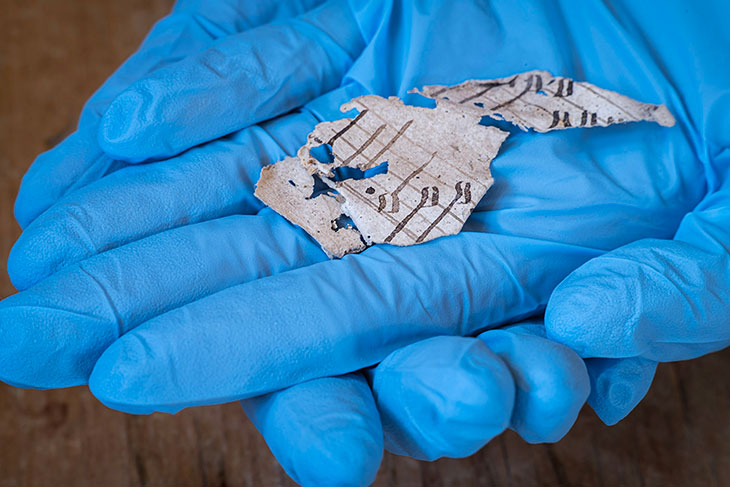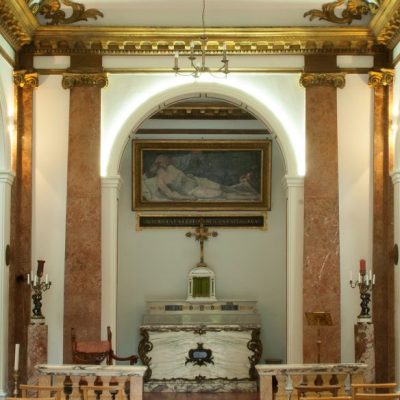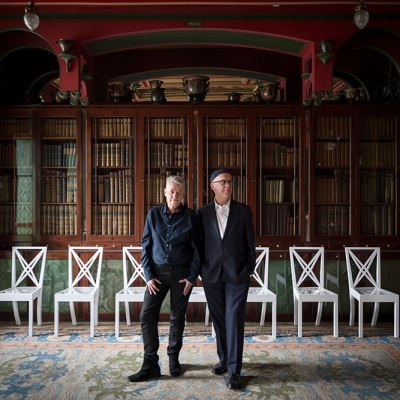Oxburgh is a moated brick-built hall in a remote fenland setting in Norfolk, home to the 18th generation of the Bedingfeld family. It was built with permission from King Edward IV in 1482 (the royal grant and seal can be seen by visitors) and is a remarkable survival: threatened with demolition in the early 1950s, the hall was saved by Sybil, Lady Bedingfeld (1883–1985), who gave it to the National Trust in 1952.
On a recent visit on a wet October day, I was greeted by the 17th-century votive picture that currently hangs at the foot of Oxburgh’s north staircase, and illustrates the Bedingfeld family’s devout Catholicism over the centuries and throughout penal times. In the painting, Sir Henry Bedingfeld, 1st Baronet (1614–85) and his wife Margaret Paston pray to the Virgin Mary as Queen of Heaven, who also shelters their three sons and five daughters beneath her cloak. Beyond, Sir Henry, loyal to Charles I, is shown fleeing the battlefield of Marston Moor in 1644 to escape by sea to Europe. Despite being ostracised and fined as recusants many times, the family had – sometime in the 1560s or ’70s, it is thought – created a priest hole in the gatehouse where they could shelter persecuted Catholic priests if the need arose. Domestic laundry was placed over nearby hedges as a signal for when Mass was to be celebrated in the private family chapel. Today, the family still practise their faith and their eldest son Richard is a Catholic priest.
Sir Henry and Lady Margaret Bedingfeld praying to the Virgin Mary (after 1661), unknown artist. National Trust Collection

The present Sir Henry, former Norroy and Ulster King of Arms, has lent documents and other objects from the family archive for display at Oxburgh. A letter from the Catholic queen Mary I confirms the first Sir Henry Bedingfeld’s appointment as Lieutenant of the Tower of London in October 1555 (he was also jailer to the future Elizabeth I during her time at Woodstock). He was briefly succeeded by his son Edmund in 1583; the inventory of the contents of Oxburgh compiled on Edmund’s death just two years later provides evidence for daily family life. Spanning the years 1699 to 1703, the diary of Thomas Marwood, guardian to the future 3rd Baronet, Sir Henry Arundell Bedingfeld, describes the education of his young charge in France and the family’s Catholic network in Europe (the diary is the subject of a recent PhD thesis by Daniel Cheely).
Other artefacts on view include the silver-gilt Bedingfeld chalice and paten, made in London in 1518–19: a rare surviving example of a pre-Reformation mass plate, acquired by the V&A in 1947 after generations of sacramental use at Oxburgh. A remarkable late 17th-century requiem chasuble with matching altar cloth records the dates of death of the parents of Sir Henry Bedingfeld (of the votive picture): Elizabeth Hoghton, who died in 1662, and her husband (also Henry Bedingfeld), who died six years earlier. The portrait of Elizabeth Hoghton in widow’s mourning remains at Oxburgh.
There are future plans to conserve and display selected Catholic memorabilia, including rosaries, sacred pendants, embroidered bourses (used as altar covers for chalices or holy texts) and personalised prayer books. But my visit was motivated by curiosity to see some exciting recent finds announced in the national news in August.
A fragment of a 15th-century illuminated manuscript found at Oxburgh Hall. © National Trust/Mike Hodgson

After the collapse of one of the attic dormer windows into the inner courtyard back in 2016, a major two-year restoration at Oxburgh commenced in 2019. This project provided the perfect opportunity to excavate the attics. Finds made by builders and the archaeologist Matt Champion, all while working through the first national lockdown, include an ‘almost intact’ copy of the Kynges Psalmes from the transcript by St John Fisher, dated to 1569, and a fragment of a late 15th-century illuminated manuscript, which was deliberately hidden for use during Catholic masses. Pieces of silk, velvet, satin and leather were extracted from a rat’s nest. Of particular interest to David Skinner, fellow and director of music at Sidney Sussex College, Cambridge are the tiny fragments of music notation in the same hand as a 16th-century manuscript in the British Library. The National Trust curator Anna Forrest, who has been responsible for Oxburgh for 14 years, explains that inches of dust and a layer of lime plaster had absorbed moisture so that many of the finds were perfectly preserved. Forrest is spearheading the research into the finds and will be sharing work in progress at a seminar on 26 November for London’s Warburg Institute. She comments, ‘The value of underfloor archaeology to our understanding of Oxburgh’s social history is enormous.’
A tiny fragment of 16th-century handwritten music, found at Oxburgh Hall. © National Trust/Mike Hodgson

The Bedingfeld family are equally enthused by these new discoveries and gratified that Oxburgh is regarded as one of the National Trust’s fifty ‘Treasure Houses’. These recent developments have inspired Thomas, Sir Henry’s younger son, to write and illustrate a children’s book about the generations of rats who cohabited with the Bedingfelds. In building their nests, the rats salvaged evidence of the family’s faith and have taken on a surprising new role as guardians of its history.
Tessa Murdoch will be respondent at a seminar on the Oxburgh finds, hosted online by the Warburg Institute on 26 November.
The restoration of Oxburgh Hall is supported by the National Heritage Lottery Fund, Culture Recovery Fund for Heritage from the Department for Culture, Media and Sport, the Wolfson Foundation and National Trust supporters.


